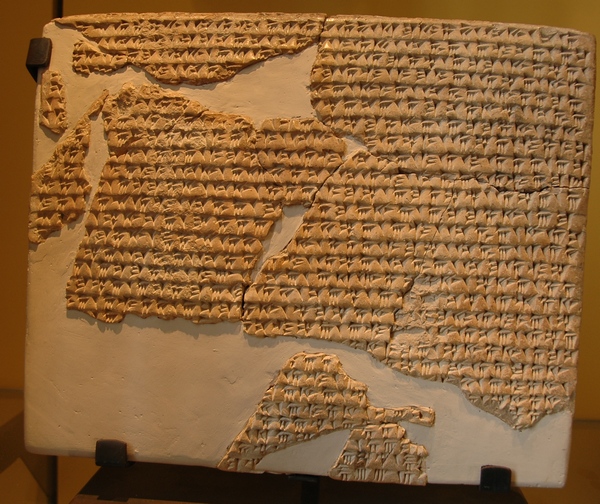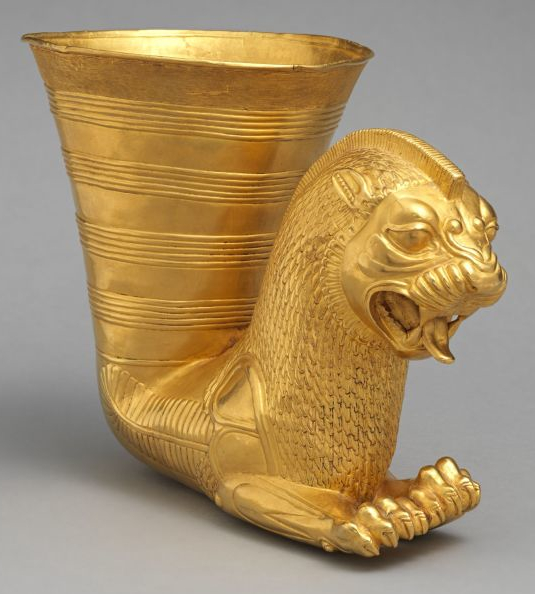Print Article
Author's Bias | Interpretation: conservative | Inclination: promise | Seminary: none

Foundation Inscriptions DSf
(Louvre Museum)
Located near the base of the Zagros Mountains in western Iran, the Achaemenid king Darius I, the Great (550
– 486 B.C.), built his winter capital and palace complex Susa some 2500 years ago, which was also at the center
of his Persian Empire.
Notable for his administrative skills, Darius the Great successfully divided his empire into
20 provinces (satrapies) and collected an annual tribute, developed trade and commerce via land and sea, and
standardized coinage, weights, and measures.
At the foundations of the palace complex Susa, inscriptions were found on several fragments of marble, clay,
and glazed tiles written in three languages: Old Persian, Akkadian, and Elamite. Scholars called these
foundation inscriptions of Susa "DSf," and they describe how Darius the Great brought craftsmen and materials
from all parts of his empire to build the beautiful royal palace of Susa.
The palace which I built at Susa, from afar its ornamentation was brought…the cedar
timber, this – a mountain named Lebanon – from there was brought. The Assyrian people, it brought to Babylon;
from Babylon the Carians and the Ionians brought it to Susa. The yaka-timber was borught from Gandhara and from
Carmania. The gold was brought from Sardis and from Bactria, from here was wrought. The precious stone
lapis-lazuli and carnelian which was wrought here, this was brought from Sogdiana. The precious stone turquoise,
this was brought from Chorasmia, which was wrought here. The silver and the ebony were brought from Egypt. The
ornamentation with which the wall was adorned, that from Ionia was brought. The ivory which was wrought here,
was brought from Ethiopia and from Sind and from Arachosia. The stone columns which were wrought, a village by
name Abiradu in Elam – from there were brought. The stone-cutters who wroght the stone, those were Ionians and
Sardians….Saith Darius the King: At Susa a very excellent work was ordered, a very excellent work was brought to
completion.

Gold Persian rhyton
(Met Museum)
The book of Esther takes place after Darius the Great, and is a record of God's people interacting with
Darius I's son Ahasuerus (Greek: Xerxes). Opening with Ahasuerus hosting a great week-long feast "for all his
officials and attendants, the army officers of Persia and Media, and the nobles and the officials of his
provinces" in the palace gardens, the book of Esther's description of "the riches of his royal glory and the
splendor of his great majesty" is consistent with the magnificence described in the foundation inscriptions.
1) Now it happened in the days of Ahasuerus, the
Ahasuerus who reigned from India to Cush over 127 provinces, 2) in those days as King Ahasuerus sat on his
royal throne which was at the citadel in Susa, 3) in the third year of his reign he held a banquet for all his
officials and attendants, the army officers of Persia and Media, the nobles and the officials of his provinces,
in his presence. 4) At that time he displayed the riches of his royal glory and the splendor of his great
majesty for many days, 180 days.
5) And when these days were completed, the
king gave for all the people present in Susa the citadel, both great and small, a feast lasting for seven days
in the court of the garden of the king's palace. 6) There were white cotton curtains and violet hangings
fastened with cords of fine linen and purple to silver rods and marble pillars, and also couches of gold and
silver on a mosaic pavement of porphyry, marble, mother-of-pearl, and precious stones. 7) Drinks were served in
golden vessels, vessels of different kinds, and the royal wine was lavished according to the bounty of the king.
(Est 1:5-7)
This correspondence provides circumstantial evidence of the historicity of the book of Esther.
According to ancient history, Ahasuerus (Xerxes) ruled the Persian Empire from 486 to 465 B.C., and the book
of Esther recorded a ten years period (483 to 473 B.C.) of his rule. This period was also during the Jews'
Exile and captivity in Babylonia.
Esther's accounting of Ahasuerus' third, seventh, and twelfth year of his rule
(Est 1:3; 2:16;
3:7) corresponds to the timeline of ancient history.
Ancient Persian history records Ahasuerus' invasion of Greece (480-479 B.C.), during the
sixth and seventh year of his reign, which ended in defeat. Upon return from the war, Ahasuerus' advisors
recommended the replacement of Queen Vashti, which corresponds to Esther's account
(Est 2:16).
However, after the seventh year of reign, there are no ancient record of Ahasuerus'
activities, during which a Jewish woman is made queen (Est 2:16-17),
Haman's edict to eliminate the Jews throughout the empire (Est 3:1-15),
and the edict by Modecai, Esther's guardian father replacing Haman (Est 2:5-7),
permitting Jews to assemble and defend themselves from any assault (Est 8:1-17).
This has caused skeptics to question if the book of Esther is a valid historical record.
While this debate may never reach an indisputable conclusion, archaeological findings continue to validate
the details of Esther's account of Persian royal lifestyle.
Among the archaeological excavations of Susa, ornate gold Persian drinking vessels (rhytons)
were recovered, which were consistent with the description of "golden vessels of different kinds" recorded in
Esther 1:7.
The chronology of ancient historical records, and archaeological findings like DSf and objects continue to
affirmed the historicity of the book of Esther, and none have controverted the Bible's account.
References:
1. From the website Livius.org: DFs
Copyright ©
2025
Helpmewithbiblestudy.org. All rights to this material are reserved. We encourage you to print the material for personal and
non-profit use or link to this site. If you find this article to be a blessing, please share the link so that it may rise in
search engine rankings.